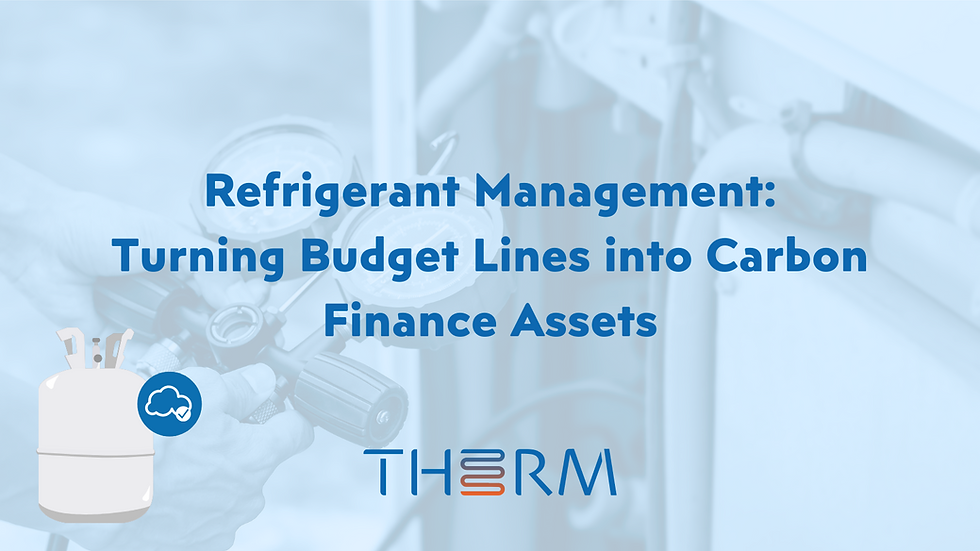Understanding the Challenges in ODS Destruction
- Matt Mohr
- Mar 14
- 3 min read
The process of ODS destruction involves several complex challenges that need to be addressed to protect the environment effectively. In this blog post, we'll explore the various challenges in ODS destruction, from understanding what ODS are to navigating the difficulties of eliminating these harmful substances. Let's dive into the key points.
Ozone-depleting substances
Ozone-depleting substances (ODS) are chemicals that cause significant damage to the ozone layer, a crucial shield that protects Earth from harmful ultraviolet (UV) radiation. Common ODS include chlorofluorocarbons (CFCs), halons, carbon tetrachloride, and methyl chloroform. These substances have been widely used in refrigeration, air conditioning, foam blowing, and fire suppression systems.
ODS Phase-Out and Repercussions
ODS were phased out because of their destructive impact on the ozone layer. The ozone layer absorbs most of the sun's harmful UV-B radiation, which can cause skin cancer, cataracts, and immune system suppression in humans, as well as detrimental effects on marine ecosystems and agriculture. The scientific discovery of the ozone hole over Antarctica in the mid-1980s prompted international action to reduce and eventually eliminate the use of ODS.
Montreal Protocol and ODS Stockpiles
The Montreal Protocol, adopted in 1987, is an international treaty designed to phase out the production and consumption of ODS. It has been successful in reducing the global use of these substances, with most ODS now banned or strictly regulated.
However, the phase-out process left behind significant stockpiles of ODS that need to be safely managed and destroyed. These stockpiles are often found in old equipment, storage facilities, and even discarded products. The ODS stockpiles are an enormous environmental disaster: even as the gas is sitting unused in a warehouse, it is leaking into the atmosphere causing significant damage.
Locating ODS Stockpiles
Locating ODS stockpiles is a significant challenge due, in large part, to the global scale of the problem. Often, these substances are stored in outdated equipment or facilities that are not well-documented. Governments, environmental agencies, and certain industry stakeholders may have records or knowledge of where these stockpiles are. However, due to the decentralized nature of ODS usage, it can be difficult to pinpoint all locations accurately. Effective tracking and reporting mechanisms are essential for identifying and managing these stockpiles.
The ODS Black Market
Despite the phase-out, a black market for ODS exists. This illicit trade is driven by several factors:
Cost - Alternatives to ODS can be more expensive, leading some businesses to seek cheaper, illegal ODS.
Compatibility - Some old equipment is only compatible with ODS, making it costly to retrofit or replace.
Lack of enforcement - in some regions, enforcement of ODS regulations is weak, allowing illegal trade to flourish.
The black market poses a significant challenge to ODS destruction efforts, as it not only perpetuates the use of these harmful substances but also makes it harder to track and manage existing stockpiles.
Infiltrating the ODS Black Market
Infiltrating the black market for ODS requires a multi-faceted approach:
Intelligence Gathering - Governments and environmental agencies need to work with industry insiders and informants to gather information about illegal ODS trade.
International Cooperation - Since the black market is often transnational, international cooperation is crucial for tracking and intercepting illegal shipments.
Technological Tools - Advanced tracking and monitoring technologies can help identify and intercept black market activities. For example, blockchain technology can be used to track the legitimate use and disposal of ODS.
Shipping: The Next Hurdle
Once organizations have tracked down stockpiles, infiltrated black market supply chains, and successfully secured tanks of ODS, they face another challenge: safe transport. Shipping ODS safely to destruction facilities is a critical step in the ODS destruction process. Here are some best practices:
Proper Containment - ODS should be stored in specially designed cylinders or containers that prevent leakage and contamination.
Compliance with Regulations - Shipping must comply with international and national regulations, including those set by the Basel Convention, which regulates the transboundary movements of hazardous wastes.
Trained Personnel - Only trained and certified personnel should handle and transport ODS to ensure safety and compliance with regulations.
Secure Transport Routes - Using secure and monitored transport routes helps prevent theft or accidental release during transit.
Documentation and Tracking - Comprehensive documentation and tracking of ODS shipments are essential for accountability and traceability. This ensures that ODS reach their intended destruction facilities without diversion or loss.
Overcoming the Challenges in ODS Destruction
Addressing the challenges in ODS destruction is crucial for protecting the ozone layer and mitigating the environmental and health impacts of these harmful substances. From understanding what ODS are to navigating the complexities of safe transport and destruction, a coordinated and comprehensive approach is necessary. By continuing to develop and implement effective strategies, we can ensure that the harmful legacy of ODS is managed responsibly and sustainably.




